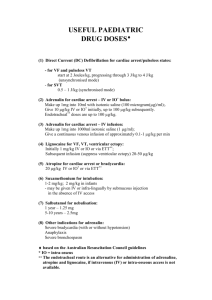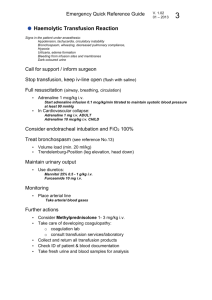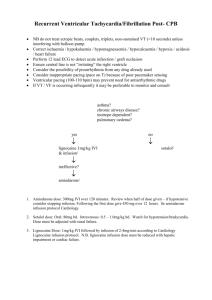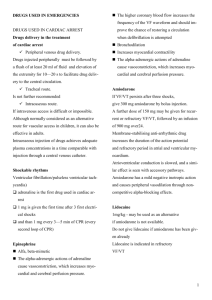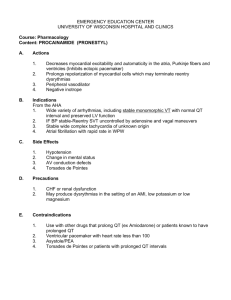1 DRUGS IN ADVANCED CARDIAC LIFE SUPPORT
advertisement
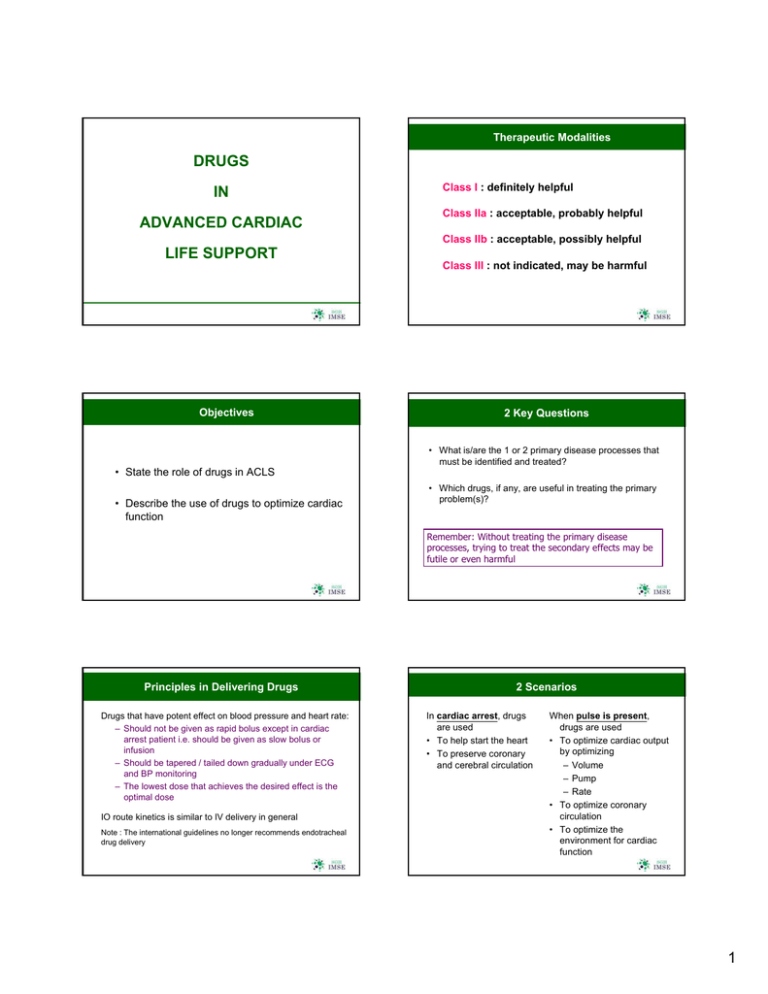
Therapeutic Modalities DRUGS IN ADVANCED CARDIAC Class I : definitely helpful Class IIa : acceptable, probably helpful Class IIb : acceptable, possibly helpful LIFE SUPPORT Objectives Class III : not indicated, may be harmful 2 Key Questions • What is/are the 1 or 2 primary disease processes that must be identified and treated? • State the role of drugs in ACLS • Describe the use of drugs to optimize cardiac function • Which drugs, if any, are useful in treating the primary problem(s)? Remember: Without treating the primary disease processes, trying to treat the secondary effects may be futile or even harmful Principles in Delivering Drugs Drugs that have potent effect on blood pressure and heart rate: – Should not be given as rapid bolus except in cardiac arrest patient i.e. should be given as slow bolus or infusion – Should be tapered / tailed down gradually under ECG and BP monitoring – The lowest dose that achieves the desired effect is the optimal dose IO route kinetics is similar to IV delivery in general Note : The international guidelines no longer recommends endotracheal drug delivery 2 Scenarios In cardiac arrest, drugs are used • To help start the heart • To preserve coronary and cerebral circulation When pulse is present, drugs are used • To optimize cardiac output by optimizing – Volume – Pump – Rate • To optimize coronary circulation • To optimize the environment for cardiac function 1 Cardiac Arrest Drugs Adrenaline • VF / Pulseless VT – Adrenaline, lignocaine, amiodarone, magnesium, others • Pulseless Electrical Activity – Adrenaline, others Primary Beneficial Effect : 1. Peripheral Vasoconstriction Improve Cerebral & Coronary Blood Flow 2. Makes VF more Susceptible to DC • Asystole – Adrenaline Adrenergic Effects Receptor Vascular A1 Constriction A2 Dilatation 1 2 Endogenous Catecholamine Important Role in Cardiac Arrest, though little evidence to show improved outcome in humans - Adrenergic Agonist Activity - Adrenergic Agonist Activity Inotropic Adrenaline Chronotropic + ve - ve + ve + ve Dilatation (Bronchial, GIT, Uterus] Adrenaline Indications : Cardiac Arrest from VF, Pulseless VT Unresponsive to Initial Counter Shock, Asystole, Pulseless Electrical Activity, or Profoundly Symptomatic Bradycardia Dose : IV 1 mg (10 ml of 1:10,000) followed by 20 ml Flush, At Intervals of 3 - 5 min * High dose” (5mg) no longer recommended Infusion : 1 mg (1 ml of 1:1000 Solution) added to 500 ml N/S or 5% D/W, run at 2 – 10 mcg/min. Titrate to 2 - 10 mcg/min High-dose Adrenaline Precaution : Adrenaline should not be added to infusions that contain alkaline solution • Not recommended for initial use since no improved Can exacerbate Ischemia, induce Ventricular Ectopy • May rarely be considered if standard 1 mg doses fail long-term survival and neurological outcome has been demonstrated 2 Optimization Drugs Sympathomimetic Amines Dosage + ++ ++ +++ Adrenaline 0.5 - 1.0 mg 1 - 20 mcg / min Noradrenaline 2 - 80 mcg / min +++ ++ Vasopressin 40 units IV bolus +++ 0 Dopamine 1 - 2 mcg/kg/min 2 - 10 mcg/kg/min 10 - 30 mcg/kg/min + ++ +++ + ++ ++ Dobutamine 2 - 30 mcg/kg/min + +++ Isoprenalin 2 - 10 mcg/kg/min + +++ 1. Pump Optimization Drugs: Vasodilator / Antihypertensive • GTN – Venous and arterial dilator – Reduces preload, reduces LV filling pressure – Drug of choice in acute heart failure/APO + IHD/ACS – Interaction with Viagra (Sildenafil) • Na nitroprusside – Arterial and venous dilator – Drug of choice in hypertensive emergencies – Potential to induce myocardial ischemia • ß blockers: e.g. propranolol, atenolol – Reduces heart rate, myocardial contractility – Caution in asthma/COLD, congestive heart failure 1.Pump Optimization Drugs: Vasopressor • Catecholamine: – Dopamine • Low dose 1-2µg/kg/min: may not change heart rate or BP • Medium dose 2-10µg/kg/min: increases heart rate and BP • High dose 10-20µg/kg/min: increases heart rate and BP • Vasopressor for hypotension from (a) bradycardia, (b) after return of spontaneous circulation – Dobutamine • 2-20µg/kg/min: increases BP, less tachycardia than dopamine and noradrenaline • Vasopressor for hypotension with (a) pulmonary congestion, (b) left ventricular dysfunction 2.Pump • BP too high • Vasodilator/ Antihypertensive • BP too low • Vasopressor 3.Rate • Too slow • Too fast 1.Volume • Fluid overload • Diuretic • Hypovolemia • Fluids / colloids • Blood transfusion 4.Coronary circulation • Vasodilator • Reperfusion • Anti-platelet, Anticoagulation 5.Environment • Oxygenation • Analgesia • Acid-base • Metabolic-endocrine • Toxin, drugs 1. Pump Optimization Drugs: Vasopressor Arrhythmogenic • Catecholamine: e.g. noradrenaline – Common effects: increases BP, heart rate, myocardial contractility – Exclude hypovolemia before using vasopressor to increase pump action / increase BP May worsen ischemia – Adrenaline • Improves coronary and cerebral perfusion pressure* • Rapid bolus only in cardiac arrest*, infusion for symptomatic bradycardia – Noradrenaline • Preferred vasopressor for septic and neurogenic shock 2. Rate Optimization Drugs for Tachycardia with Wide QRS • Common effects: reduces heart rate, reduces BP • Lignocaine* – Use for VF, VT, wide complex tachycardia of unknown origin – Numbness of mouth and digits is a sign of toxicity • Amiodarone* – Use for VF, VT, SVT, atrial fibrillation-flutter – Reduces clearance of warfarin, digoxin • Magnesium* – Drug of choice for Torsades de Pointes • *Rapid bolus only in cardiac arrest, otherwise give as infusion for tachycardia 3 Lignocaine Reduces Automaticity, elevates VF Threshold Indications : • Haemodynamically stable VT (Class IIb) • Refractory VF / pulseless VT (Class indeterminate) • Control of haemodynamically compromising PVCs (Class indeterminate) Note : Lignocaine is now a second choice behind other alternative agents in many of these circumstances Lignocaine Evidence no longer supports the use of lignocaine as a diagnostic discriminator between perfusing VT and widecomplex tachycardia of uncertain origin Lignocaine is NOT recommended for ventricular escape rhythm Lignocaine is no longer indicated to prophylactically suppress ventricular dysrhythmias associated with acute myocardial infarction and ischaemia (causes higher mortality) Lignocaine Dosage : In Cardiac Arrest • 50 – 100 mg (Given as bolus IV because of poor blood flow & prolonged circulatory times) • May add a second bolus of 0.5 mg/kg • After restoration of spontaneous circulation, Lignocaine IV Infusion 1 - 4 mg/min • If dysrhythmia reappears during infusion of lignocaine : - give small IV bolus of 0.5 mg/kg - increase infusion rate in incremental doses to max rate of 4 mg/min Lignocaine Toxicity (Dose should not > 3 mg/kg bolus) Neurological Changes Drowsiness, Disorientation, Decreased Hearing Ability, Paresthesia, Muscle Twitching, Agitated, Fits Myocardial Depression Circulatory Depression Amiodarone Amiodarone Indications : • A complex antidysrhythmic agent: - effects on Na+, K+, and Ca++ channels - alpha-and beta-adrenergic blocking properties • pharmacological conversion of atrial fibrillation (Class IIa) • Also alters conduction through accessory pathways • haemodynamically stable VT (Class IIb) • persistent VT or VF after defibrillation and adrenalin/vasopressin (Class IIb) • haemodynamically stable polymorphic VT (Class IIb) • haemodynamically stable wide-complex tachycardia of uncertain origin (Class IIb) 4 Amiodarone Indications: • control of rapid ventricular rate in preexcitation Amiodarone Adverse Effects: Hypotension and Bradycardia supraventricular dysrhythmias due to accessory pathway conduction (Class Ilb) • as an adjunt to electrical cardioversion of refractory PSVTs/atrial tachycardias (Class IIb) • slow the rate of infusion • IV fluid challenge • pressors or positive chonotropic agents • temporary pacing • control of ventricular rate in SVTs with severely impaired LV function when digitalis has proved ineffective (Class Ilb) Amiodarone Magnesium Dosage: • in VF / pulseless VT - administer bolus of 300 mg. Subsequent dose at 150 mg • A cofactor in numerous enzymatic reactions • In stable ventricular and supraventricular dysrhythmias - administer IV 150 mg over 10 - 15 minutes (not to exceed 30 mg/min), followed by an infusion of 1 mg/min x 6 hours, then 0.5 mg/min • Essential for function of Na-K ATPase Pump Note: infusions > 2 hours must be administered in glass or polyolefin bottles due to amiodarone precipitating in plastic tubing • Mg deficiency associated with cardiac arrhythmia, sudden death, precipitates VF, hinders replenishment of intracellular K+ Magnesium Indications : Magnesium Dosage : Note : • 1 - 2 g magnesium sulfate (2 - 4 ml of soln) The routine prophylactic use of magnesium in patients with AMI is no longer recommended • Diluted in 100 ml of 5% D/W over 1 - 2 min, may give up to 5 - 10 G Proven hypomagnesaemia with or without dysrhythmias 50% • Monitor BP 5 Magnesium Tachycardia with Wide QRS: Lignocaine, Amiodarone Side Effects : • Flushing, Sweating, Mild Bradycardia, Hypotension, Asystole • Hypermagnesemia may produce Depressed reflexes, Flaccid paralysis, Circulatory collapse, Resp paralysis, Diarrhoea • Rapid administration of magnesium may cause clinically significant hypotension or asystole 2. Rate Optimization Drugs for Tachycardia with Narrow QRS • Common effects: reduces heart rate, reduces BP • Adenosine – Half-life < 6 seconds: super rapid bolus needed – Side effects: bronchospasm, angina-like chest pain, flushing, transient hypotension • Verapamil, Diltiazem – Ca-channel blockers – Vasodilates coronary arteries – Do not use in Wolf-Parkinson-White syndrome – Avoid concomitant use with ß blockers Verapamil / Diltiazem Calcium Channel Blockers Potent Direct Negative Chronotropic & Negative Inotropic Effects Primary Beneficial Effect : • Both slow conduction and increase refractoriness in the AV node • Diltiazem produces less myocardial depression than verapamil, but is equipotent as a negative chonotrope • ß blockers • Amiodarone Verapamil / Diltiazem Indications : • Treatment of PSVT • Slow down Ventricular response in Atrial Verapamil / Diltiazem Dosage of Verapamil : • I.V 1 mg/min • Maximum 20 mg in total dose Flutter & Fibrillation (But not for AF with WPW) Dosage of Diltiazem : • I.V 0.24 mg/kg (approx 20 mg) over 2 min • May repeat 0.35 mg/kg 15 min later • Infusion 5 - 15 mg/hr titrate to heart rate for control of Ventricular Response in AF 6 Verapamil / Diltiazem • Transient Hypotension due to peripheral vasodilation may occur Verapamil / Diltiazem Precautions : • May cause hypotension • Not to use with I.V Beta Blocker • I.V calcium chloride 5 - 10 ml of 10% solution will restore arterial pressure, without affecting the electrophysiological properties of verapamil • Avoid in sick sinus syndrome, AV Block or Heart Failure • Diltiazem IV is incompatible with simultaneous IV Frusemide Adenosine • An endogenous purine nucleoside that slows conduction through AV node • Interrupts AV nodal re-entry pathways • Restores normal sinus rhythm in PSVT (including PSVT associated with WPW) Adenosine Indications : • Termination of PSVT (Re-entry type) • Diagnosis of SVT Dosage : • Short-lived pharmacologic response • 6 mg bolus over 1 - 3 sec, followed immediately by 20ml saline flush • Half-life of free adenosine 5-10 sec (sequestrated by circulating RBCs) • If unsuccessful, give 12 mg bolus (may be repeated once to a total dose of 30 mg) Note : preferably administer via antecubital or central IV line Adenosine Tachycardia with Narrow QRS: Adenosine, Verapamil, Diltiazem Precaution : • Side effects are transient: • Flushing, Dyspnea, Chest Pain, Transient Bradycardia, Asystole • Drug Interaction with • Theophylline & related xanthines - block effect of adenosine • Dipyridamole potentiates effect of adenosine • Relatively C/I in asthma 7 2. Rate Optimization Drugs for Bradycardia 3. Coronary Circulation Optimization Drugs • Vasodilator – GTN • Reperfusion – Thrombolytic – PCI • Antiplatelet – Non-specific • Aspirin – Specific • Clopidogrel (Plavix) • Glycoprotein IIb/IIIa inhibitors (GP IIa/IIIb): Risk of hemorrhage • Anticoagulant – Heparin – Low molecular weight heparin e.g. fraxiparine • Atropine – Vagolytic i.e. inhibits parasympathetic action – Large doses needed for acute cholinergic poisoning (organophosphates) – Side effects similar to adrenaline, can also cause seizure, respiratory failure – Given in a dose of 0.6mg intravenously & may be repeated at 3 – 5 min intervals up to a max dose of 2.4mg • Adrenaline infusion • Dopamine infusion Case NN 4. Environment Optimization Drugs • Oxygen • Morphine • NaHCO3 – Use in hyperK, tricyclic overdose, pre-existing acidosis, prolonged cardiac arrest – Do not mix with other drugs • Calcium – Use in hyperK, hypoCa, Ca-channel blocker overdose • HyperK treatment – Insulin+dextrose, calcium, NaHCO3, resonium etc • • • • A 53 year old man c/o chest pain BP 75/47, PR 45, RR 22, SaO2 97%, ECG as above 1° problems: Inferior, right ventricular AMI, complete heart block What drugs are useful? Case NN: Optimization B. Pump • RV AMI: RV pump failure - BP too low • Dopamine C. Volume • RV pump failure: insufficient venous return to pulmonary system – “Hypovolemia” • Judicious fluids D. Rate • Complete heart block: atropine, [pacing], (adrenaline or dopamine infusion) A. Coronary circulation • Vasodilator: GTN -CAUTION! • Reperfusion: PCI, SK, rTPA • Anti-platelet: aspirin, Plavix • Anticoagulation: heparin Case FEW • 19 year old maid c/o GE symptoms x 3 days, then SOB • GCS 3, BP 68/41, PR 100, RR 18, SaO2 95 • Blood sugar 19.8, ECG sinus • pH 6.6, pCO2 53, HCO3 5, BE –30 • CXR acute pulmonary edema Environment • Oxygenation • Analgesia: morphine • 1° problems: Cardiogenic shock from ?myocarditis, DKA • What drugs are useful? 8 Case LSW Case FEW: Optimization A. Pump • LV pump failure – cardiogenic shock • Dopamine C. Environment • Oxygenation: intubation • Acid-base: NaHCO3 • Metabolic-endocrine: insulin • 72 year old man c/o non-radiating left chest pain x 45 min • HPT, smoker • Brought in to ED with GCS 15, SBP 42, PR 60, RR 20, SaO2 96% B. Volume • Dehydration from GE, DKA • CVP monitoring • Judicious fluids • Hs1s2, lungs clear • Right radial and carotid pulses weaker than left • Remained comfortable in Resus Room Case LSW Case LSW: Optimization B. Pump • Maintain lowest possible myocardial contractility • Keep SBP 90-110 • • • • ECG X 3: no change Chest X-ray showed widened mediastinum 1° problems: Thoracic aortic dissection What drugs are useful? A. Volume • Aortic dissection relative hypovolemia • Judicious fluids Coronary circulation • Vasodilator: GTN CAUTION! • Reperfusion: SK, rTPA • Anti-platelet: aspirin • Anticoagulation: heparin C. Environment • Oxygenation • Analgesia: morphine Summary • In cardiac arrest, drug administration is secondary to other interventions • When pulse is present, drugs are used – To optimize cardiac output by optimizing • Volume • Pump • Rate – To optimize coronary circulation – To optimize the environment for cardiac function • The key to management is to identify the primary disease process(es) and use the appropriate drugs, if any, to optimize the deranged process(es) 9
